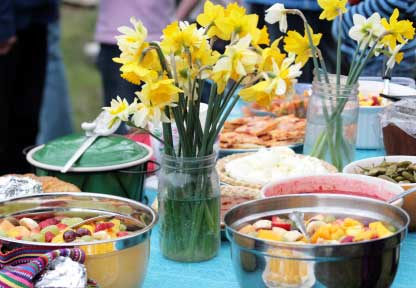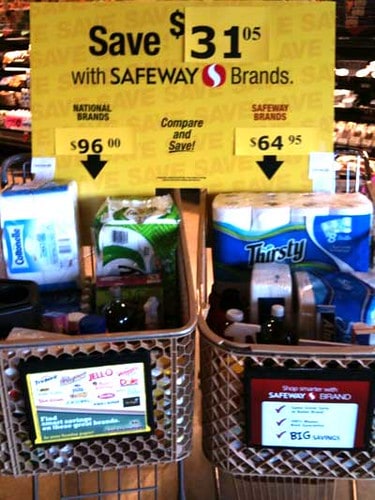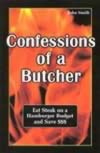The art of the potluck

Potlucks are a frugal way to entertain and bring people together to share good food. Even with quality ingredients, making food at home lets us eat well for less. The hosts provide the space, the organization, a dish or two, and perhaps a theme to spice it up a bit. The guests each bring something for the feast, and the focus is on enjoying everyone's contribution.
This distributes the cost and effort (enabling more people to host), and makes gatherings more group-oriented. If everyone is on a tighter budget, a potluck still feels like a treat — but with a lower bill. The food choices are usually more varied, too! Continue reading...
Slash your grocery bill with store-brand products

If concern about taste has kept you from trying store-brand foods, hesitate no more. In blind tests, our trained tasters compared a big national brand with a store brand in 29 food categories. Store and national brands tasted about equally good 19 times. Four times, the store brand won; six times, the national brand won.
In other words, store brands offer roughly the same quality as national brands, but at a much-reduced cost. How much reduced? Consumer Reports says that the store brands they tested cost an average of 27 percent less than the name brand equivalents.
Buying food: Grocery shopping tips from 1950
The American housewife! Who has a more important or more responsible occupation? Wife, mother, laundress, counselor, maid, chef, purchasing agent. All of these are her duties at one time or another.
So begins Buying Food, a home economics film from 1950. Buying Food is fascinating not just for its shopping tips, but also for the inside look at a grocery store from 60 years ago. (Self-service grocery stores were introduced in 1916 and grew in popularity during the 1920s and 1930s, but they were still relatively young in 1950.)
The condescending narrator e-nun-ci-ates his thesis:
Cut your food costs with a stand-alone freezer
Kris and I recently bought another side of beef. Well, to be more accurate, we purchased one third of a cow. Every year, we go in with several other families to split an animal. This year, our portion of the purchase comprised:
- 46 pounds of lean hamburger (in 24 packs)
- 36-1/8 pounds of roasts (in 10 packs)
- 31-1/4 pounds of steak (in 20 packs)
We also received 2-1/4 pounds of beef tongue that we're giving to the guys at the box factory. José and Jesus tell me that lengua is delicious, but I'm not willing to prepare it myself. (If they want to make something for me, I'll eat it.)
We received a total of 115-5/8 pounds of beef for $425, which is an average cost of $3.66 per pound. (In December 2006, we paid $300 for 83 pounds of beef, for an average of $3.61 per pound. In November 2007, we paid $277 for 81 pounds of beef, an average of $3.42 per pound.)<
An Experiment in Cheap Living (from 1872)
An Experiment in Cheap Living
Earlier this week, I shared some of the highlights from three years of GRS articles about saving money on food. Brett from The Art of Manliness, who knows that I collect old self-help books, sent me an excerpt from Dio Lewis's 1872 volume, Our Digestion, or, My Jolly Friend's Secret. Here Lewis describes his "experiment in cheap living", during which he spends just 54-1/4 cents for a week of food. This makes for some amusing reading. Enjoy!
It is now Saturday afternoon, and I will tell you in confidence, my dear reader, a little of my personal, private experience during the past week.
How to save money on food: Great tips from three years of Get Rich Slowly
While driving to our monthly book group discussion on Saturday, Kris and I had a conversation with our friend Courtney. Courtney's family is beginning to feel a financial squeeze. Her husband's employer is cutting jobs. To keep working, he'll have to take a pay cut and move back to the position he left a couple of years ago.
"I've started to read personal finance books," Courtney told us. "We know we're going to have to make do with less money, so I'm looking for advice. I'd really like to learn how to cut back on groceries, for example."
"Oh, you should read Get Rich Slowly," Kris said. "J.D. writes about that all the time."
Gary Vaynerchuk: 12 Wines for Under $12
Wine is one of those little things that bring me pleasure. I enjoy discovering new wines, but I'm not a wine snob. As I've mentioned before, my favorite wines are those that taste great but don't break the bank.
I recently asked Gary Vaynerchuk — host of Wine Library TV — if he could suggest some good inexpensive wines for spring and summer. Gary put together a special episode of his program just for GRS readers:
"You want to talk about 'get rich slowly'? Look for value plays in wines," Gary says. "If you don't overspend on wine, you've got more money in the bank!"
How to Save $100 (or More) at the Grocery Store This Month
.jpg) When gas prices were soaring in the summer of 2008, my family was scrambling to find ways to save money. We could not reduce the prices at the gas pumps, we were locked into the lowest interest rate on our mortgage, and our budget was maxed out. I knew the only way we could continue without running into the red each month was to reduce the line item marked Grocery — but I didn't know how exactly to go about doing that.
When gas prices were soaring in the summer of 2008, my family was scrambling to find ways to save money. We could not reduce the prices at the gas pumps, we were locked into the lowest interest rate on our mortgage, and our budget was maxed out. I knew the only way we could continue without running into the red each month was to reduce the line item marked Grocery — but I didn't know how exactly to go about doing that.
At that same time, I discovered the world of personal finance blogs and frugality blogs. It was through these blogs that I found myself a "job". It wasn't a job that earned our family any income; it was a job that involved spending less of the income that my husband worked so hard to earn. My new job? Grocery store savings expert!
My new grocery-shopping techniques allowed me to save over $100 the first month, and close to $200 the second month. Our monthly grocery budget dropped from around $500 to $300. (And sometimes less!) Here are the steps I took to save at the supermarket:
<Starting seeds indoors: Jump-start your garden today
In some parts of the U.S., vegetable and flower seeds can be successfully planted directly into the garden. But in many areas, the growing season is too short to allow this.
Cool spring soil temperatures and cold weather can prevent seeds from germinating or kill young seedlings. If you wait until the weather warms, the plants get off to a late start only to be zapped by fall's first frost; they don't get a chance to bear a full crop or to put on a full floral display.
There are three solutions for home gardeners:
Confessions of a Butcher: Eating Steak on a Hamburger Budget
 Every week, I receive a couple of books in the mail from authors and publishers. (This week there were six!) They're hoping that I'll find time to review their work at Get Rich Slowly. I do my best, but it's impossible to read everything.
Every week, I receive a couple of books in the mail from authors and publishers. (This week there were six!) They're hoping that I'll find time to review their work at Get Rich Slowly. I do my best, but it's impossible to read everything.
When John Smith offered to send me his book, Confessions of a Butcher, I wasn't expecting much. I've read a few niche books like this, and they're usually uninspiring. As a full-fledged carnivore, I'm please to report this one is different. Smith spent more than 30 years in the meat industry, and he's used his experience to produce a short book packed with information.
Confessions of a Butcher contains: